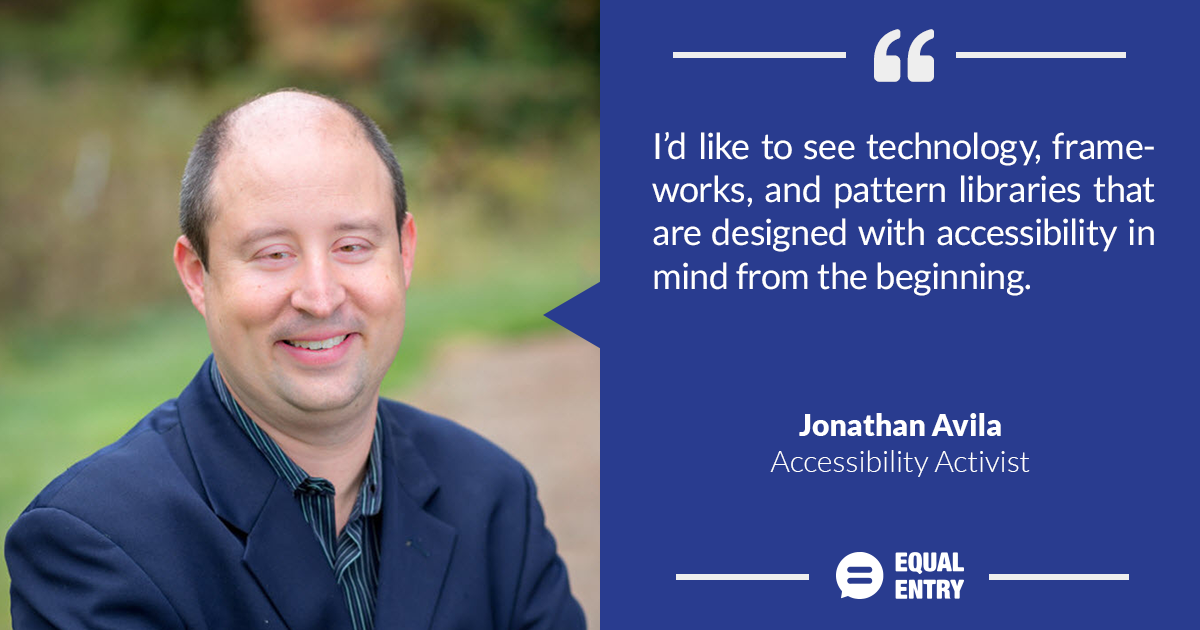This installment of our Accessibility Activists column is an interview with Jonathan Avila, Chief Accessibility Officer for SSB Bart Group. Avila is also a participant in the WCAG Working Group, and the mobile accessibility task force at the WAI.
When did you first get started in accessibility?
I worked at a summer family vacation retreat/camp for adults who were blind/visually impaired in New York. I started teaching campers Windows 95, MS Office, and the Internet with JAWS 3.2. Back then you had to reformat the page into one column before reading each page with JAWS. There was no virtual/browser cursor yet. Most blind people I worked with hadn’t really had a chance to use the Internet or even explore Windows, and they were just amazed to find out what was possible at that time. Seeing the benefits that assistive technology could bring was amazing.
What project are you most proud of from your work in accessibility?
I had many projects and I can’t limit it to one. The most important include but are not limited to:
- Creating JAWS scripts for many customers – most of whom worked at call centers. I created JAWS scripts that allowed people to be efficient and often out-perform their sighted peers by creating shortcuts and streamlining the process of taking calls. Many of my scripts ran for years and across multiple versions of systems and JAWS without breaking. I came from a programming background, and thus when I joined this field, I wanted to programmatically solve these issues in a robust way that relied on using MSAA, the document object model, or COM rather than what my predecessors had done, which was to write macros based on screen coordinates, specific colors, or other techniques that were fragile. I felt like myself and others like Doug Lee helped to transform the scripting industry with modern programming practices. Our predecessors were well intentioned people, most of whom came from a rehab background, but who were not programmers.
- Codifying the knowledge I had learned into best practices in SSB Bart Group\’s AMP (Accessibility Management Platform). When SSB and BART Group combined in 2005, I was given the chance to take the knowledge in my head related to accessibility of software and web, and to put it into writing which is now the AMP best practice library. Other people did and have contributed significant material – but much of the content was written based on what I had learned from working since the late 1990s. The AMP best practice library pre-dated much of WCAG notes and techniques that we now have, so it was a great resource when few other resources were available. It remains a great resource and the library goes beyond web content that is addressed by WCAG notes.
- Implementing accessibility into frameworks. I was involved in writing accessibility implementations for frameworks such as Adobe’s Flex framework. Whenever we have the chance to write accessibility into a framework, the impact is so much more significant for accessibility support because the support is there automatically in standard controls without requiring developers to consider adding it in.
What is your current area of focus in the accessibility field?
I’m actually involved in many areas. For example, I’m actively involved in the WCAG WG and the mobile accessibility task force at the WAI. I’ve been involved in the creation of mobile standards and guidelines for accessibility within several organizations. I actively commented on the Section 508 refresh and have been planning updates in AMP for the refreshed standards. At the same time I have been refining our automated tests for web content and working on automatic test criteria for native mobile content.
What accessibility barrier would you like technology to solve?
There are many barriers that technology can assist to dissolve. I could name many things like social interaction, gaming, way finding, employment, education, and transportation. One large challenge is that technology and frameworks are created with accessibility as an afterthought. I’d like to see technology, frameworks, and pattern libraries that are designed with accessibility in mind from the beginning. If this were the case, technology could readily be the solution to other barriers as soon as it’s available.

2 comments:
Comments are closed.